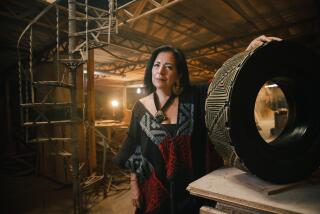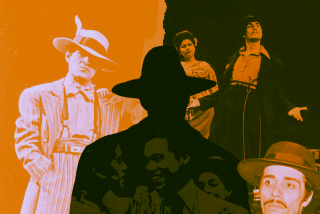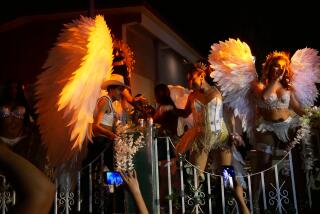Naked and posing in Mexico City
- Share via
MEXICO CITY — People usually strip for love or money. But Isaac Esquivel and thousands of other Mexican men and women dropped their clothes in neat piles early Sunday and pranced naked around the main plaza of this capital just for the heck of it.
New York photographer Spencer Tunick, famous for rounding up people to pose naked in cities around the world, brought his fetching artistic gimmick here. His goal was to persuade more than 7,000 residents of this very Roman Catholic country to disrobe in front of God, one another and a media army perched on the roof of the downtown Holiday Inn. City officials estimated as many as 20,000 people might have taken part.
“At first I was really nervous,” said Esquivel, 25, who also is a photographer. “I kept thinking about what they tell you before you make a speech, you know, to imagine your audience naked.”
He didn’t have to wait long. At 6:50 a.m., the disrobing began at Tunick’s signal, and, after tossing aside their workaday identities, people began running to the center of the capital’s historic plaza, known as the Zocalo.
‘Part of human life’
Within minutes, the square was filled with pink flesh and dark hair, a chanting, shouting, gleeful party in the light of dawn, the gathering framed by the Metropolitan Cathedral, City Hall and the National Palace.
“Nudity is part of human life,” said Liliana Velasco, 30, an anthropologist. “Being naked is being in the moment, and being naked in the Zocalo gives everyone a chance to celebrate our culture.”
Not quite, maybe, what the 16th century Spaniards had in mind when they set aside the plaza for the heart of their new empire. The giant square is the scene of concerts, political rallies and parades. Hundreds of thousands of protesters have raised their fists here. Most years, the Mexican president gives the annual cry for liberty from the balcony of the National Palace to kick off Independence Day celebrations.
Esquivel said he found his own freedom Sunday. “After you take off your clothes, you see that everybody is the same,” he said. “That’s when I stopped being nervous and started to have fun.”
That didn’t last too long either. Tunick and his assistants began herding the naked volunteers for the first say-cheese moment.
“Everybody take a stone,” barked Tunick, referring to the large stone squares that form the floor of the Zocalo.
The one-person, one-stone command lent order to the crowd. Tunick asked them to pose in the Mexican salute, which is held not at the forehead but chest-high. A woman lost her nerve and ran out of the crowd. She dressed and left in a hurry.
‘Otra, otra!’
After he finished with that pose, the crowd chanted, “Otra, otra!” Another one, another one.
Tunick then asked that they lie down on the cold stones, feet facing north. Mexico City is in its warm season, but the early morning temperature was in the 60s. By 7:30 a.m., the crowd was kneeling, head down, curled up in the so-called snail pose. It looked as though they were bowing to the cathedral, Mexico’s oldest.
A few shouted for Cardinal Norberto Rivera Carrera to join them. Tunick had promised while negotiating for city permission that he would not include the cathedral in any of the photographs.
Shortly after 8 a.m., Tunick dismissed all the men -- about three-quarters of the crowd -- and broke the spell that for a couple of hours had united several thousand strangers in an odd intimacy.
Tunick and his helpers corralled the women into a corner of the Zocalo for one last shot while the men dressed. Most stuck around to watch. And some began to cheer, injecting a bit of wolf-whistle attitude that was absent when everybody was naked.
“Thank you for participating, but would all the men please return to the street, please!” shouted one organizer. “No photographs please. No cellphone photographs, please.”
Everybody was dressed by 9 a.m. as the street sweepers gave the Zocalo a once-over.
“What a great moment for the Mexican art scene,” Tunick said later. “The heart of Latin America is now in Mexico.”
sam.enriquez@latimes.com
More to Read
Sign up for Essential California
The most important California stories and recommendations in your inbox every morning.
You may occasionally receive promotional content from the Los Angeles Times.










